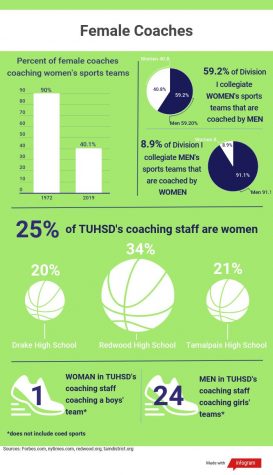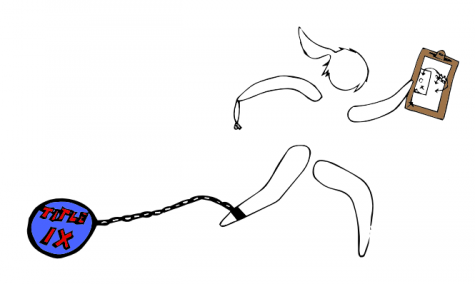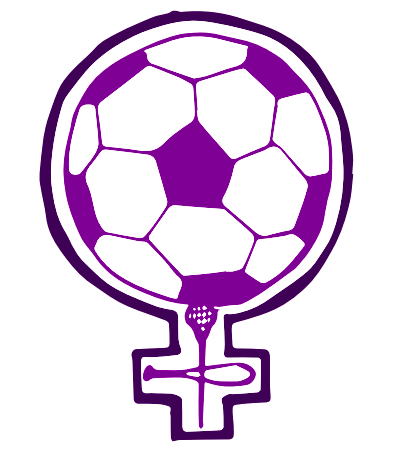Female coaches could foster confidence within both boys’ and girls’ sports
March 17, 2020

Now, more than ever before, appears to be the era of female power in the United States. The #MeToo movement and a band of female senators are just a couple of examples. With all these women in powerful positions, it would be reasonable to assume that women play a larger role in sports, but coaching positions continue to be dominated by men.
According to the New York Times, children who start playing sports at a younger age tend to look up to their coaches, and due to male-dominated athletics, they learn to associate leaders with men. These unbalanced leadership roles are reflected in both politics and executive jobs of profitable corporations, where women remain the minority, according to Catalyst, a global nonprofit that works with companies to guide women into leadership. The New York Times states that female coaches could help to further break down the barriers of gender roles by allowing young athletes to grow up being mentored by all genders and reinforcing women’s abilities as leaders.
Hallie Brauner, the Branson boys’ varsity basketball assistant coach and one of the few women who coach a Marin County Athletic League (MCAL) boys’ team, highlights that women can have positive impacts on the lives of the children they are coaching and serve as an example of a leader.
“I think sports teams can be incredible vehicles for change and empowerment in a kid’s life, but, in boys sports especially, they can be a breeding ground for toxic masculinity,” Brauner said. “I think that for my boys, and for boys in general, it’s super important to have a mix of female and male sports role models.”
According to The Institute for Diversity and Ethics in Sports (TIDES), women held 8.9 percent of head coach positions for men’s sports at Division I universities in 2018. Conversely, men held 59.2 percent of head coach positions for female sports.

A handful of women, such as Katie Sowers, an assistant coach for the San Francisco 49ers, and Alyssa Nakken, an assistant coach for the San Francisco Giants, have defied the odds by earning full-time positions coaching men’s sports professionally. Sowers was the first woman to coach a football team in the Superbowl, and Nakken, a former softball star for Sonoma State University, became the first female coach in Major League Baseball. Both of these women began their careers interning for the professional sports leagues and have since earned their spots among the male professionals.
While a few women have broken into the ranks of coaching for professional, renowned leagues, they remain anomalies. The lack of female coaches as role models for men’s sports and professional sports in general does little to encourage women to coach men’s sports, according to Brauner.
“I think that a lot of women don’t think about coaching boys. If you’re going to step into a coaching role, it would be for girls. I think that would be most women’s impulses, because you don’t see [women coaching men’s sports],” Brauner said. “As soon as we start seeing [women coaching men professionally], that’s when I think we will really see more women thinking about coaching boys. Because if you see it in the NBA, if you see it in the NCAA, it’ll trickle down.”
The disparity between female and male coaches was ironically caused by Title IX, a federal law implemented in 1972 with the goal of ensuring equality within school athletics for both genders. In 1972, women held 90 percent of the head coach positions in female sports, but shortly after the amendment was passed, they quickly became outnumbered by men. Male coaches were suddenly interested in coaching women’s teams once they would be equally funded and therefore have competitive salaries. Female coaches were pushed aside as female collegiate sports earned more prestige. Nowadays, women only hold 40.1 percent of head coach positions in women’s collegiate Division I sports, according to Forbes.
Women’s lack of interest in sports compared to men is another possible explanation for the disparity between women and men coaches, although it is undermined by the overwhelming evidence that female coaches were very involved in female athletics before Title IX passed and increased wages for those coaching positions.
Although there are plenty of interested female candidates for coaching at the college level, finding applicants to coach a high school sport can be a little more challenging, especially at public schools. Chris McCune, the Tamalpais Union High School District (TUHSD) athletic coordinator, says that the low wages of high school coaching jobs often deter potential applicants regardless of gender, so there are fewer candidates. Because there are fewer women in the coaching field, the district has a larger proportion of male applicants so there tend to be more male coaches within TUHSD.
Due to the limited applicants, TUHSD’s women coaching demographic varies from school to school. At Redwood, Tamalpais and Drake High Schools, approximately 34 percent, 21 percent and 20 percent of coaches are women, respectively. Overall, the district has a female coaching staff of roughly 25 percent, and, not including coed sports, only one woman as a head coach for a boys’ team, Drake’s boys’ varsity volleyball. Comparatively, there are 24 men coaching girls’ sports within the district.
Despite the lack of female coaches in our district, collegiately and professionally, a Harvard study conducted in 2013 contends that gender-balanced leadership roles improved teams’ performances. When the American Psychological Association tested people for leadership skills, men tended to test more positively for confidence, while women were likely to be more competent, thus demonstrating that women can be just as or more knowledgeable about sports than men.
Junior Hudson Grace, a cross country and track and field athlete, has noticed that his female coaches have approached coaching with a different style than his male coaches. Although he has had little experience being coached by a man, he notes that his previous female coaches have been well-respected and successful.
“I would say the main difference [between male and female coaches] is that women – not to stereotype at all – are more respectful and more involved in the kids’ lives,” Grace said. “I think that guys could also do really good jobs, but in my own experience, I’ve just seen [that women] are really compassionate, which is useful because you need to be able to maintain a good relationship with your athletes.”

Similarly, Nicole Graydon, the Redwood cross country and track and field coach, feels that men and women bring different attributes to the team through their individual coaching styles. She recounts her interaction with an athlete who felt that a more positive coaching style, rather than the traditional aggressive method used to coach boys, helped him perform better.
“Sometimes the boys want to be pushed in a more aggressive way, just that very stereotypical way,” Graydon said. “I think guys get coached by guys in a very aggressive manner. I think women coaching men’s sports can bring a different perspective and the same amount of sports knowledge just like guys coaching women can be a good balance.”
To create that balance of genders, trailblazers such as Katie Sowers and Alyssa Nakken have to continue to show that they, along with all women, are able to lead teams just as strongly as men.
Brauner understands the importance of female role models, not only for young girls, but for boys as well.
“I love it when I see women coaching young women because we need more of that, but we also need a lot more women coaching young boys,” Brauner said. “They need to see that strength, sports intelligence and sports prowess can not only come from men, but also women.”







